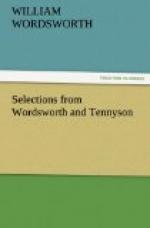228. MY FOREHEAD AND MY EYES. Compare the note to line 132. Here the specific terms are used according to the epical manner instead of the general term “face.”
232-233. Compare the Gospel of Matthew ii. 11.
240-242. These often-quoted lines have been already referred to above. Their very intellectuality is alien to the spirit of the original. In Tennyson’s conception they afford the central meaning of the poem, and also of the completed Idylls. We must bow to the will of God who brings all things in their due season. Good customs too deeply rooted are like clear waters grown stagnant.
254-255. FOR SO—GOD. The idea that the earth is bound by a gold chain to heaven is comparatively common in literature from Homer downwards. Archdeacon Hare has a passage in his sermon on Self-Sacrifice which doubtless was familiar to Tennyson: “This is the golden chain of love, whereby the whole creation is bound to the throne of the Creator.”
257-258. IF INDEED I GO—DOUBT. There is no reason to suppose that these lines indicate Tennyson’s personal misgivings on the subject of immortality.
259. THE ISLAND VALLEY OF AVILION. Mr. Rhys in his Studies in the Arthurian Legend combats the old idea that Avalon (Avilion) meant the “Island of Apples” (Welsh aval, apple). The name implies the Island of King Avalon, a Celtic divinity, who presided among the dead.
The valley of Avalon was supposed to be near Glastonbury, in Somersetshire, where Joseph of Arimathea first landed with the Holy Grail.
67 ff. There is an evident symbolical meaning in this dream. Indeed Tennyson always appears to use dreams for purposes of symbol. The lines are an application of the expression; “The old order changeth,” etc. The parson’s lamentation expressed in line 18, “Upon the general decay of faith,” is also directly answered by the assertion that the modern Arthur will arise in modern times. There is a certain grotesqueness in the likening of King Arthur to “a modern gentleman of stateliest port.” But Tennyson never wanders far from conditions of his own time. As Mr. Stopford Brooke writes; “Arthur, as the modern gentleman, as the modern ruler of men, such a ruler as one of our Indian heroes on the frontier, is the main thing in Tennyson’s mind, and his conception of such a man contains his ethical lesson to his countrymen.”
THE BROOK
Published in 1855 in the volume, Maud and other Poems. The Brook is one of the most successful of Tennyson’s idylls, and is in no degree, as the earlier poem Dora was, a Wordsworthian imitation. The brook itself, which bickers in and out of the story as in its native valley, was not the Somersby brook, which does not now “to join the brimming river,” but pours into the sea. The graylings and other details are imaginary. A literary source has been suggested (see Dr. Sykes’ note) in Goethe’s poem, Das Baechlein, which begins:




